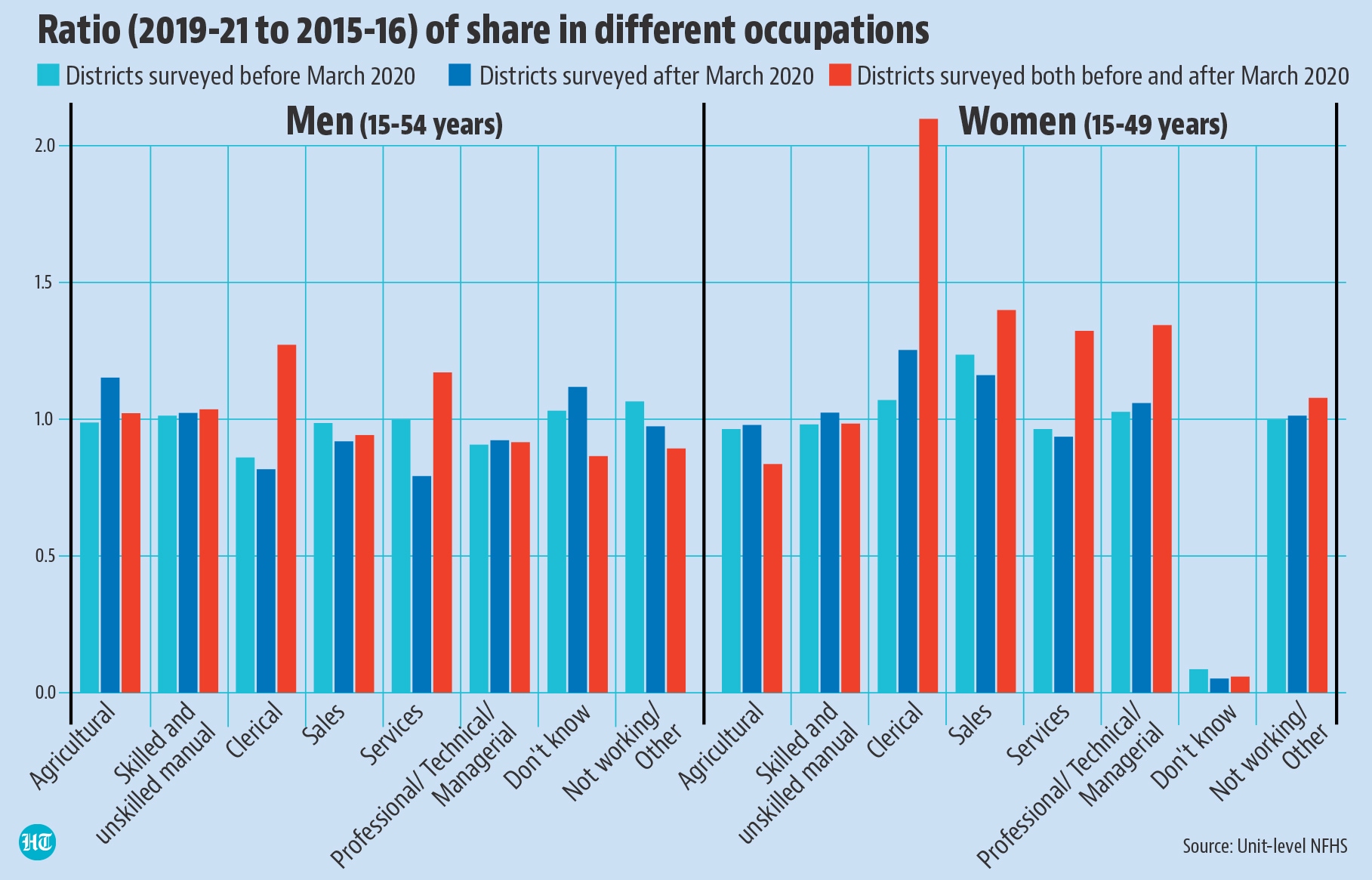Number Theory: What does NFHS tell us about the pandemic’s employment impact?
An HT analysis of unit level data from the National Family and Health Survey (NFHS) shows that the economic pain in labour markets did not decrease enough with the removal of lockdown restrictions.
Did the Covid-19 pandemic have a lasting impact on employment in India? There is no official data to answer this question in a comprehensive manner at the moment. The latest annual report of the Periodic Labour Force Survey (PLFS) – it is the official source of employment statistics in India – is available for the July 2019 to June 2020 period. It does show a sharp increase in unemployment during the period of the 68-day long nationwide lockdown which began on March 25.

But what happened to labour markets after the lockdown was lifted? While quarterly employment reports of PLFS are available up to December 2021, they only cover urban labour markets and do not have as much information as the annual reports.
It is in this void that the recently released unit level data of the fifth round of the National Family and Health Survey (NFHS) – it was conducted between June 2019 and May 2021 – emerges as a useful proxy for the pandemic’s impact on employment. An HT analysis of unit level data from NFHS shows that the economic pain in labour markets did not decrease enough with the removal of lockdown restrictions.
But first, a caveat on NFHS employment numbers
Because NFHS is not focused on employment alone, there is a qualitative difference between employment statistics available in NFHS and PLFS. It is important to list these differences upfront and the resultant limitations of NFHS data to make inferences about the state of labour markets in India.
One, the criteria for being considered employed is much more liberal in NFHS than PLFS. NFHS asks whether a person worked or had work (but was on leave) in the week before the survey or if the person worked at any time in the year before. To be considered employed in the past week in PLFS, a person should have had work for at least one hour on at least one day of the week. To be considered employed in the year before, the person should have had work for at least one month.
Two, NFHS only seeks responses on employment related questions from men and women in the age-group of 15-54 years and 15-49 years respectively, while PLFS asks this question to all members of the household. This has an impact on the total sample for employment in NFHS and PLFS. In the 2019-21 NFHS, 101,839 men and 108,785 women gave responses on the employment question. The 2019-20 PLFS had a much bigger sample; 213,063 men and 205,170 women.
Three, unlike PLFS, which surveys every part of the country in each quarter, the NFHS sampling is spread across the entire period of the survey and therefore prone to more seasonal contamination.
These differences, however, do not make NFHS employment numbers worthless. A comparison of the latest PLFS and NFHS shows that NFHS over-estimates the share of working people but not very drastically.

NFHS data does suggest a lasting adverse impact of the pandemic on labour markets
One way to overcome the seasonal contamination problem in the NFHS is to compare clubbed districts which were surveyed before and after the lockdown and compare the change in their employment indicators with the previous round which was conducted in 2015-16. HT has used a unit level data analysis to make three such district groups – districts surveyed completely before March 2020, districts surveyed partly before and partly after March 2020 and districts surveyed completely after March 2020 – to make this comparison. To be sure, no district was canvassed between April 2020 and September 2020 and the NFHS only resumed from October 2020 onwards, by when the lockdown restrictions had been largely removed (so when we say after March 2020, it automatically means after September 2020).
A simple comparison of headline employment numbers – currently working, and who usually work all year – shows the biggest proportional fall in male employment for the districts which were surveyed after March 2020. For women, the degree of increase in employment was less in districts surveyed after the pandemic than in those surveyed before. To be sure, an increase in women’s work participation is not surprising -- it increased by a bigger degree compared to men even between the 2017-18 and 2019-20 PLFS. This calculation has excluded respondents who reported working seasonally or occasionally as it would not be uncommon for them to not be working when the survey was being conducted.

NFHS data also shows a shift towards farming/manual work
For men, who constitute a majority of the work force and largely drive the overall labour market trends, the NFHS data show a change which is similar to what is seen in the PLFS data: a shift towards agriculture. The share of men employed in agricultural work increased in the districts surveyed after the pandemic in NFHS, while this share decreased in the districts surveyed before the pandemic. A somewhat similar trend – more increase in post-pandemic districts than in pre-pandemic ones – is seen for share of men doing manual work. To a lesser degree, these trends were also true for women.

To be sure, because NFHS does not allow comparison of quarters, it is possible that the long-term trends of specific regions have contributed to the trends shown above. Therefore, it is only PLFS that can give complete clarity on the post-pandemic scenario in the job market.
Get Current Updates on India News, Lok Sabha Election 2024 live, Infosys Q4 Results Live, Elections 2024, Election 2024 Date along with Latest News and Top Headlines from India and around the world.






